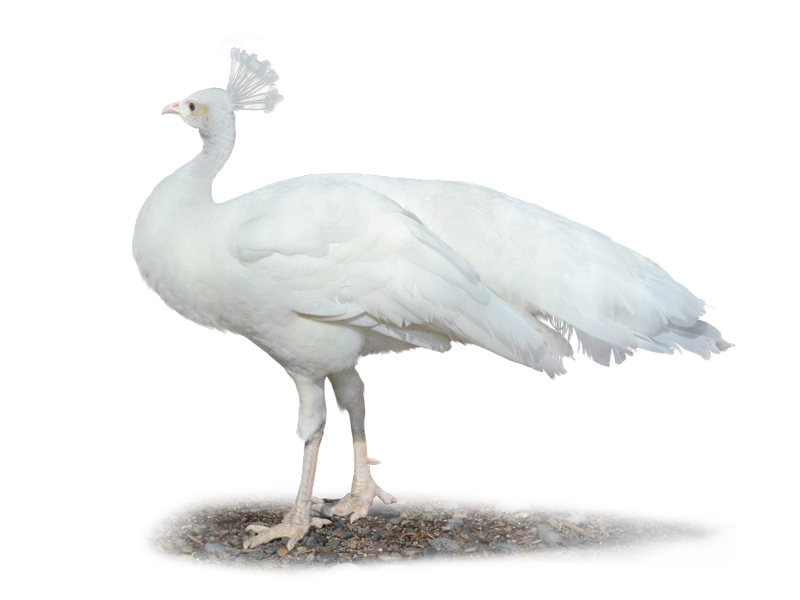
Pavo cristatus domestic white
白変種がインドクジャクのみに存在する謎
The Mystery of Leucism, Which Only Exists in Indian Peafowl
インドクジャクの白変種であり、原産地であるインドではヒンドゥー教の信仰において幸運と繁栄をもたらす存在として信じられています。自然下で見られるのは稀であり、動物園の飼育下で繁殖された個体を目にすることができます。
シロクジャクは生まれた時から真っ白ではありません。実は最初は黄色で、成長とともに徐々に白くなります。中には半分または部分的に白色になる個体もいます。メラニンの遺伝情報が欠損しているアルビノと違い、メラニンが不足することで白色化するので瞳の色は黒くなっています。白変種は劣性遺伝性であり、優性遺伝子の下に隠れて遺伝します。確実に白いクジャクが生まれるには、両親が白変種である必要があり、両親が共に通常の体色の場合は、その子孫が白変種とになる確率は4分の1です。
不思議なことに白変種が見られるのはインドクジャクのみで、クジャクの仲間であるマクジャク (Pavo muticus) やコンゴクジャク (Afropavo congensis) には白変種の存在は報告されていません。インドクジャクは分布域が広く、個体数も多いため、突然変異が現れる確率も相対的に高いのが要因だと言われていましたが、その謎は近年の研究により解明されました。PMELというメラニンの沈着・構造に関わる重要遺伝子がインドクジャクのみに存在しており、PMELが発現低下することで白化羽毛変異の形成につながる可能性がわかったのです。
白変種は通常のインドクジャクに比べて負けず劣らず美しく、繁殖期のオスによる羽を広げたディスプレイは、ウェディングドレスに例えられるように華やかで神聖な姿です。実際にヨーロッパでは結婚式のセレモニー時のためにシロクジャクをレンタルするサービスもあるそうです。クジャクは古今東西の文化においてあらゆる象徴的な存在となり、絵題となってきましたが、江戸時代以降の日本の絵師たちをも魅了してきました。シロクジャクに限ると、狩野恒信 (1636 – 1713) による「白孔雀牡丹図」が最初の作品だと考えられます。他には伊藤若冲 (1716 – 1800)の「老松孔雀図」が有名で、こちらも白孔雀と牡丹を大胆な構図で描いています。牡丹と孔雀の組み合わせは、富貴や権勢、華麗さを象徴する伝統的な吉祥の絵題なのです。
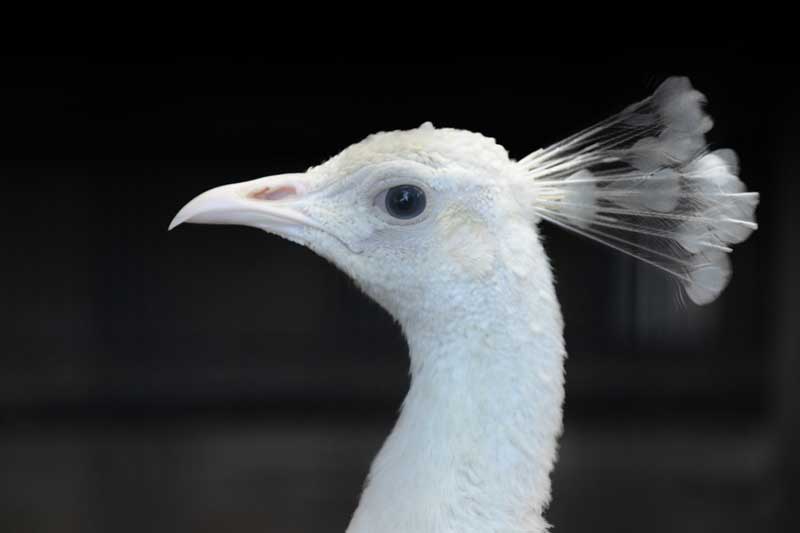
Albinos lack the genetic code for melanin, resulting in red, translucent pupils, while Leucism have normal melanin production, resulting in black pupils.
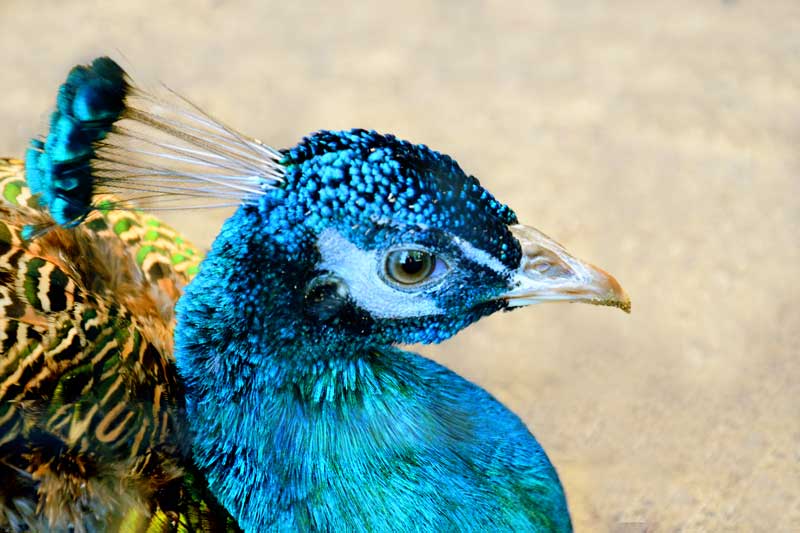
Peacocks have a regular arrangement of melanin granules, which causes light to reflect and interfere, resulting in a vivid color.ed by a special blue color created by structural coloration. White peacocks are white due to a lack of melanin.
The white peafowl is a leucistic variant of the Indian peafowl. In its native India, it is believed to bring good fortune and prosperity in Hinduism. While it is rare to see them in the wild, captive-bred individuals can be found in zoos.
White peafowls are not born pure white. In fact, they start out yellow and gradually whiten as they grow. Some individuals are half or partially white. Unlike albinos, which lack the genetic code for melanin, white peafowls are white due to a lack of melanin, resulting in black eyes. Leucism is a recessive trait and is inherited under a dominant gene. To ensure a white peafowl is born, both parents must be leucistic. If both parents are normal-colored, there is a one-in-four chance that the offspring will be leucistic.
Curiously, leucism is only found in Indian peafowls; no leucism has been reported in other peafowl species, such as the green peafowl (Pavo muticus) or the Congo peafowl (Afropavo congensis). It was thought that the reason for this was that the Indian peafowl has a wide distribution range and a large population, which means that the probability of mutations occurring is relatively high, but this mystery has been solved by recent research. It has been discovered that PMEL, an important gene involved in the deposition and structure of melanin, is present only in Indian peafowl, and that reduced expression of PMEL may lead to the formation of the leucism feather mutation.
Leucism is just as beautiful as regular Indian peafowl, and the display of males’ wings during the breeding season is so gorgeous and sacred that it has been likened to a wedding dress. In fact, there are apparently services in Europe that rent white peafowls for wedding ceremonies. Peacocks have become a symbolic presence and subject of art in all cultures, past and present, both Eastern and Western, and have fascinated Japanese artists since the Edo period. The first work featuring a white peacock is thought to be “White Peacock and Peonies” by Kano Tsunenobu (1636-1713). Another famous example is “Peacock and Old Pine Tree” by Ito Jakuchu (1716-1800), which also depicts a bold composition featuring a white peacock and peonies. The combination of peonies and peacocks is a traditional auspicious subject, symbolizing wealth, power, and splendor.
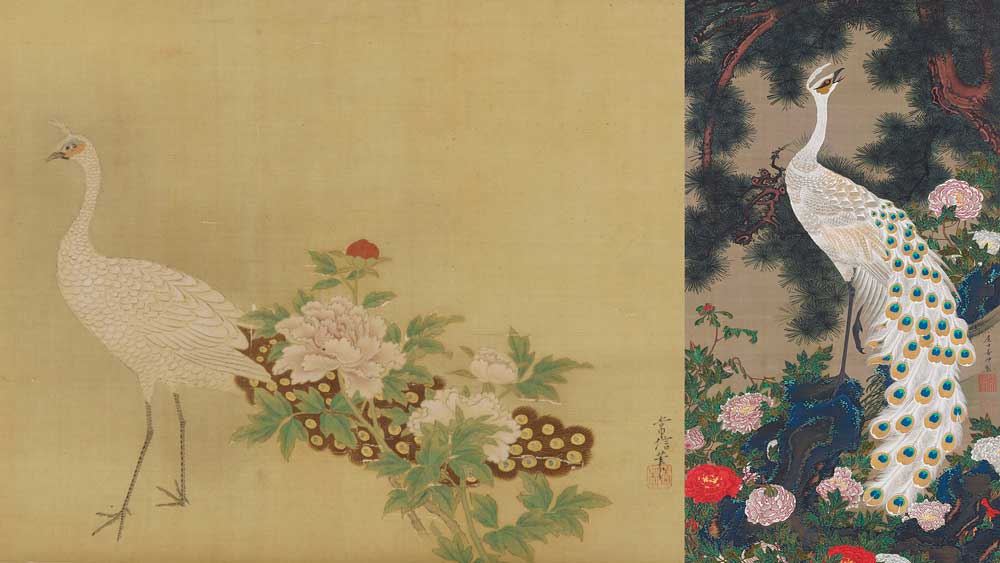
(右) 伊藤若冲 (1716 – 1800)「老松孔雀図」/ Ito Jakuchu (1716-1800) “Peacock and Old Pine Tree”
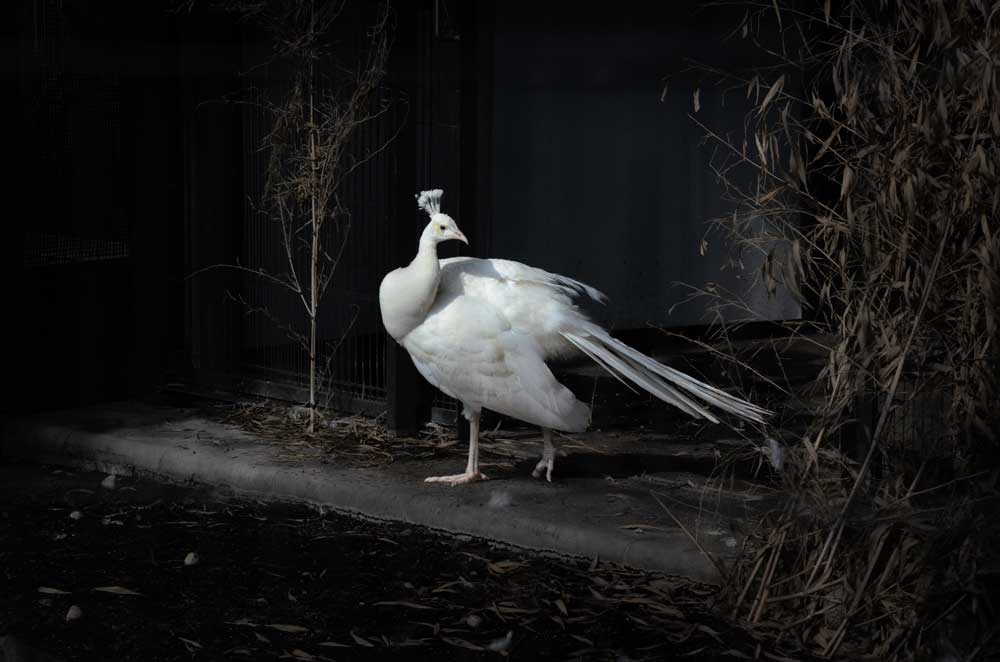
参考文献
Stone, J. J. (2024, June 8) “White Peacocks: Facts, Symbolism, and Images” Treehugger, People Inc. 2025年9月13日閲覧
一般社団法人色材協会 | 色材コラム | Vol.10 クジャクの羽の構造色 | (2022年3月31日) 2025年9月13日閲覧
「シロクジャク&マクジャク」Poppo No.37 (2013年1月) 久留米市鳥類センター 2025年9月13日閲覧
“Peacocks for your Engagement, Wedding or Corporate event” Peacocks UK. 2025年9月13日閲覧
“White peacock and peonies” National Museum of Asian Art, Smithsonian Institution. 2025年9月13日閲覧
皇居三の丸尚蔵館 | 所蔵品 | 老松孔雀図 2025年9月13日閲覧